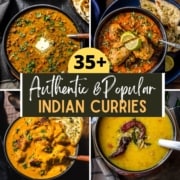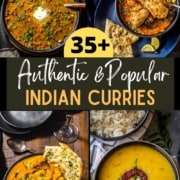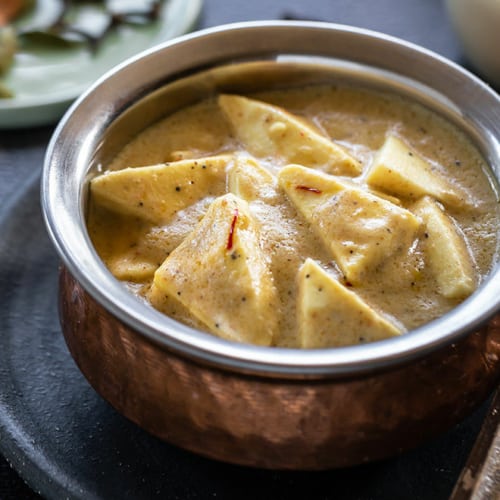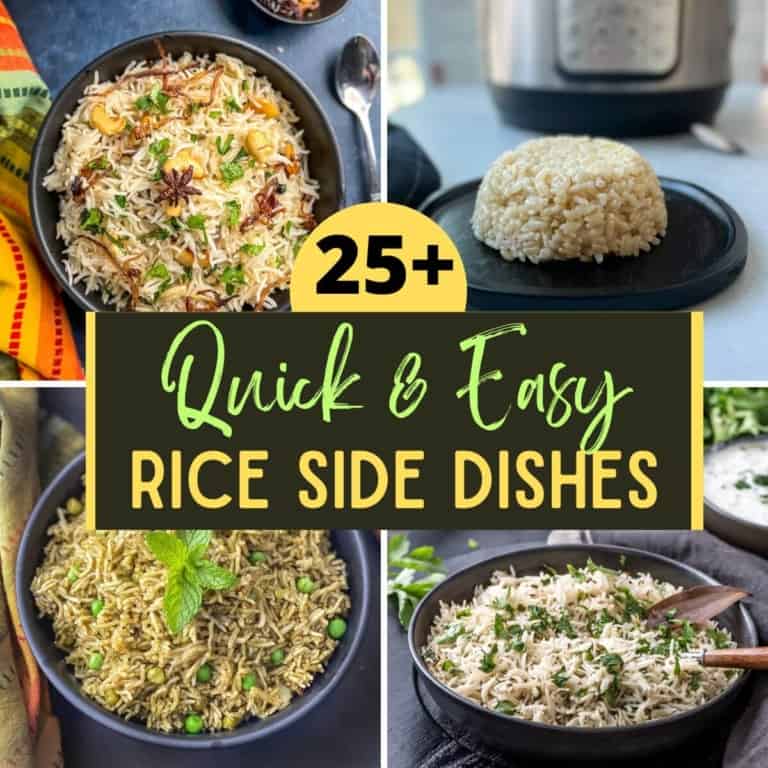35+ Authentic and Popular Indian Curries
Note: This post contains affiliate links. As an Amazon Associate I earn from qualifying purchases.
Learn all you need to know about Indian curries and get some authentic and popular recipes that’ll get you cooking in no time. Check out this collection that includes 35+ traditional curry recipes from all over India!
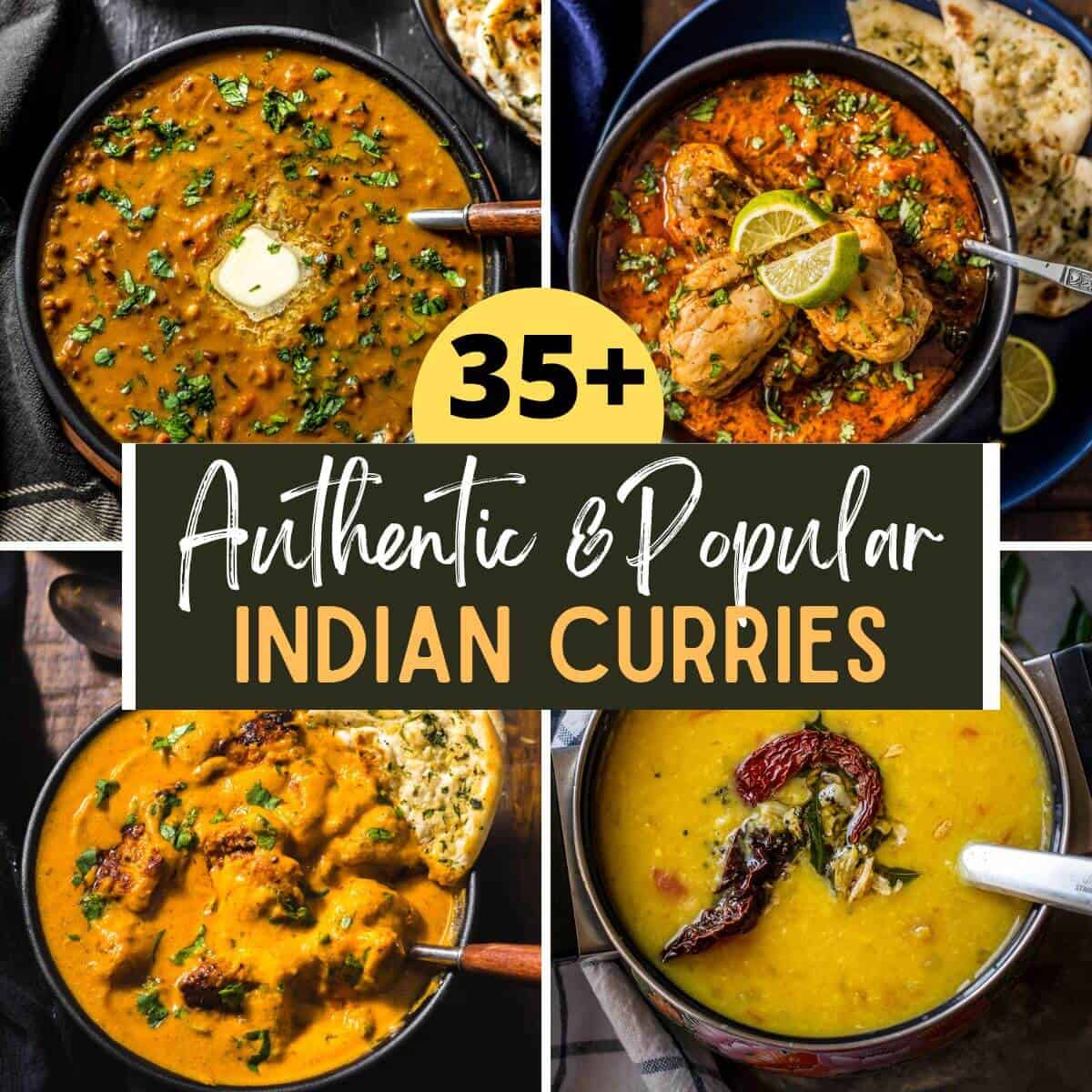
What is curry?
Curry is generally understood to be a spice-infused dish, usually in a sauce or paste base in which vegetables, lentils, and meat are cooked.
Usually, the curries with more sauce (wet curries) are accompanied by rice, and the dry ones (with reduced sauce) are served with Indian flatbreads such as roti or naan.
Origin of curry
Most people will agree that the word curry originated from the Tamil word “Kari,” which means a sauce seasoned with spices that is served with rice.
The story goes that when the Portuguese colonized Goa (a state in Western India), they started referring to the spiced saucy dish (kari) that the locals ate as ‘caril’ or ‘caree,’ and when the Britishers came along later, they anglicized it to “curry.”
The truth is that the flavorful gravy that the rest of the world now thinks of as curry can be a combination of so many different ingredients and cannot be generalized by one name. For the average Indian, each of these gravy-based dishes have individual names such as chicken tikka masala, veg korma, dum aloo, etc. (more on that later).
Yet, the fact of the matter is most Indian restaurant menus globally, and online publications such as blogs, append the word curry to the Indian names of these recipes so that the rest of the world can relate to it.
A quick note about curry powder
As far as Indian cuisine is concerned, there is nothing called curry powder. The British came up with this spice mix to recreate the flavors of the food they had in India.
The concept of curry powder does not sit well with Indian cuisine. Most Indian dishes have their own unique blend of whole spices and powders that are used to impart a distinct flavor.
The only thing that comes close to curry powder is garam masala powder – a spice powder popularly used in North Indian cooking. If you are into making spice blends at home, here’s a link to the few essential Indian spice mixes that I make at home – Homemade Indian spice blends.
To summarize, the words curry and curry powder were coined by Britishers, not Indians.
Indian dishes and their names
Ever wondered how the Indian curry dishes got their names? While I was researching the different kinds of curries, I realized that most Indian curries were named either after their place of origin, the primary ingredients used, the cooking method, or cultural influences. Here are a few examples –
- Place of origin – The popular Udupi Sambhar, a frequent accompaniment to dosas and idlis, refers to Udupi, a city in Karnataka state. Similarly, Chettinad Chicken refers to the Chettinad area in Tamilnadu.
- Ingredients used – Butter chicken or chicken makhani got its name because of the copious amounts of cream and butter used in the curry. Other examples would be Achari (pickled) chicken, Bhindi Dopiaza (okra cooked with twice the amount of onions), etc.
- Cooking method – An example would be Dum aloo, where whole potatoes are cooked in a spicy sauce on low heat for several hours (also called dum cooking). Other cooking styles include bhuna (stir-fry), and tandoori (made in a clay oven), to name a few.
- Cultural influences – Curries with names that are suffixed by Mughlai, Afghani, Parsi, etc., indicate the culture it was influenced by.
Popular Indian curry names explained
Now that you know how curries in India are generally named, let me share what the names of some very popular curries mean. That way, when you are in an Indian restaurant browsing through the menu, the names will make more sense, and you’ll have a better idea of what to order.
Here are the top 20+ popular Indian curry names explained
Achari – Curries that use the same spices that are used for making Indian pickles (achaar in Hindi) are called achari. The most common spices used are fennel, nigella, and red chilies. These curries have a tangy flavor and can be mild to very hot.
Bharta – A bharta is a mash. It is generally made with mashed aubergines (brinjal/eggplant) or potatoes; cooked in a spiced onion-tomato gravy. The vegetables are normally chargrilled or boiled, which softens the exterior, and the skin is then peeled off, following which the vegetable is then mashed before being cooked.
Balchao – Balchao refers to the method of cooking where the seafood is pickled in a spicy and tangy tomato-vinegar-based sauce. This style of cooking is popular in Goa. The curry is made with either fish or meat. It is almost like a pickle and can be stored for several days.
Bhuna – Bhuna means stir-fried. Whole spices are stir-fried in oil to release the flavor, and then the rest of the ingredients are added. The most distinguishing feature of a bhuna dish is that the meat or vegetables are cooked in their own juices, and no or very little water is added. This renders a sauce that is thick and viscous.
Dal or Dahl – Any legume-based dish can be classified as a dal/daal. They can also include vegetables or leafy greens.
Dum – When a curry or a rice dish is cooked in a sealed pan over low heat, it is generally said to be “dum-cooked.” Once all the ingredients are added to the pot, it is sealed with dough so the meat or vegetables cook in their own juices under pressure.
Dhansak – This is a curry that has its origin in Parsi cuisine. These curries have a sweet and sour taste and are mildly spiced. Dhansak generally consists of meat and vegetables cooked with lentils and sometimes can also include spinach or fenugreek greens.
Gosht – Curries that contain goat meat (also called lamb or mutton in India) are named gosht. These curries are sometimes combined with lentils.
Hyderabadi – This means that the curry or biryani dish takes its name from the city of Hyderabad, which is in South India. Mughlai and Arabic cuisines, along with local Telangana and Marathwada cuisines, have been a huge influence on Hyderabadi food.
Jalfrezi – Jalfrezi is an anglicized version of the word jhal porhezi, where jhal means spicy food and porhezi (derived from the Persian word parhezi) means suitable for a diet. This curry is a throwback to the times when Brits ruled India and is a fusion of Anglo-Indian influences. It contains green chilies that are stir-fried with tomatoes and onions to create a thick sauce in which meat or vegetables are cooked.
Jhol – Jhol means sauce; this dish comes from the state of West Bengal and is distinguished by the presence of mustard oil. It is a thin gravy that may contain fish, meat, or vegetables.
Kadhai – The Indian version of the wok is called a kadhai. This curry is essentially cooked in the kadhai and renders a sauce that is thick and coats the main ingredients, which could be any meat, fish, or vegetable. You may also see this type of curry referred to as balti.
Kadhi – Kadhi is a thick yogurt-based curry that is mildly flavored. Chickpea flour or lentil paste is used to thicken the curry, which may contain pakoras, legumes, or vegetables. There are many varieties of kadhi, and each region of India has its own version. Some may be sour; others may be sweet and sour. Some are mild with very few spices; others may be more robust.
Kheema – Minced meat is known as kheema or keema in India. Usually, ground meat is stir-fried with onion, tomatoes, garlic, ginger, and a few Indian spices before it is cooked to a gravy-like consistency.
Kofta – Kofta has Persian origins and means ‘to grind,’ referring to the ground meat used in making them. Though koftas are traditionally made from meat in the middle east, you’ll find vegetarian versions made from potatoes and cream in India.
Korma – The word korma is derived from the Urdu word qorma, which means to braise. Braising involves cooking at high heat, followed by slow cooking to finish the dish. This technique works particularly well for chicken since it locks in flavors and makes the meat succulent. A korma sauce was traditionally made from yogurt, almonds, and saffron, along with a few spices. Over the years, turmeric has replaced the expensive saffron, and almonds are often substituted with cashews.
Makhani – Makhani refers to makkhan or butter in Hindi. A makhani curry may refer to the smooth, silky, thick texture of the gravy as well as the inclusion of butter and cream in the sauce. Makhani curries may have paneer or chicken as the main ingredient.
Malai – A malai (cream) curry almost always contains a paste of cashew or some other nut paste as the base, along with yogurt and cream. The curries are mild and aromatic and tend to be a little on the sweet side. Spices like cardamoms and cloves give this dish its distinct taste and smell.
Masala – Masala is a mixture of various spices, onions, garlic, ginger, tomatoes, etc. Any curry that contains a mix of spices and herbs can be termed a masala curry. The taste, ingredients, and heat quotient of a masala curry depends entirely on the cook. It can range from mild to extremely hot.
Moilee or Molee – Moilee means stew. Fish Molee (Fish Molly or Meen Moilee) is a Kerala-style fish curry where fish is cooked in a coconut milk-based gravy.
Mughalai – This cuisine came to India with the Mughals. The curries are rich and cooked with aromatic spices, essences, dried fruits, and nuts. Most modern Mughlai dishes are cooked with nut pastes which form the base for a thick and creamy curry that is mildly hot.
Pasanda – This curry is derived from the word ‘pasanday,’ meaning loved by all. It is mildly flavored with a cashew base. Though normally cooked with meat, it may also be made with Indian cottage cheese called paneer.
Roghan Josh – Rogan means oil or clarified butter in Persian, and josh means fiery or hot, referring to the deep red color of the dish. Mutton or lamb rogan josh is a Kashmiri curry made from lamb or goat meat and is generally not spicy – thanks to the use of the mild Kashmiri chili powder.
Saag – Green leafy vegetables such as spinach, mustard greens, etc, are called saag in India. When referring to curries, it generally means blanched green leafy vegetables that have been blended into a paste and cooked with herbs and spices. Potatoes, paneer, and meat are added to this green sauce to make a saag dish.
Salan – In certain cultures and regions, curry is known as salan. So, any gravy-based dish can also be called salan. Mirchi ka salan, or green chili salan, is a famous curry from Hyderabad.
Shahi – Shahi cuisine normally contains highly aromatic spices and herbs along with nuts which creates a very thick and rich curry. It may contain meat, vegetables, or paneer as the main ingredient.
Tarka/Tadka/Baghaar – Tadka means tempering. Most Indian gravies go through this process in the beginning or at the end. Some curries even call for tempering twice.
Tikka masala – This dish originated in England (surprise, yes!) when boneless grilled pieces of chicken tikka were added to the mildly hot and aromatic gravy. Though it originally used chicken as the main ingredient, you can now find paneer tikka masala, mutton tikka masala, and even mushroom tikka masala on many menus.
Vindaloo – The word vindaloo is derived from the Portuguese word ‘carne de vinha d’alhos,’ which means meat in a marinade of wine (vinho) and garlic (alho). A Goan specialty, vindaloo curries are known for being spicy. While it is traditionally made with pork, other meats such as lamb or chicken have become popular replacements over the years.
How to make curry
The most popular Indian curries have an onion-tomato base to which coconut milk, cream, or yogurt is added to give it a creamy texture. There are curries in the South that use more indigenous ingredients like tamarind instead of tomatoes (after all, the tomato was introduced to India less than 800 years ago).
When you look through the recipes below, you’ll realize there is no one way or formula to make curries. Every recipe uses a unique set of spice and spice powders which makes the taste of that curry so unique.
Having said that, there are two basic Indian sauces that you can make in big batches so that you can whip up the most popular north Indian curries in half the time. That’s the trick most Indian restaurants follow as well 🙂
- Onion tomato masala (bhuna masala) – A curry sauce (bhuna masala) is a base onion-tomato masala gravy that can help create delicious Indian meals in a fraction of the time. Use it to make the most popular Indian recipes, from biryanis to curries like kidney beans (rajma) or chana masala – all with the same base sauce.
- Tikka masala sauce – For those who want to balance the need of wanting to eat fresh food every day without spending hours in the kitchen, a simmer sauce like this one is a perfect solution. Add fresh or frozen vegetables, meat, seafood, paneer, and tofu to this tikka masala sauce to create delicious meals in minutes.
Authentic Indian Curry recipes
The most common curries on any Indian restaurant menu include the ubiquitous makhani, tikka masalas, korma, etc. However, there are many other curries that are just as delicious. Check out these 35+ different types of Indian curry recipes, and hopefully, some of them will inspire you to try something new!
Indian vegetarian curries
Some of my favorite curries are vegetarian. This list of dal, paneer, pulses, and vegetable curries are some of the classic Indian curry recipes that you’ll find in Indian homes as well as on restaurant menus.
Dal tarka/tadka/baghaar
Tadka dal, also called yellow dal, is made by cooking dal (tuvar or moong) along with onions, tomatoes, and green chilies in a pressure cooker or an Instant Pot. Once the dal is cooked, it is tempered with oil, cumin/mustard seeds, red chilies, and asafoetida.
To make it a one-pot dal recipe, start with the tempering, add the remaining ingredients, and cook them. Easy peasy!
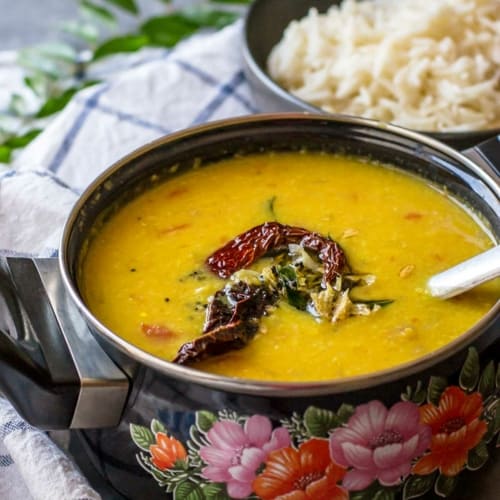
Dal makhani
If you have never had dal makhani before, think of it as a creamy, lightly-spiced curry made from whole urad dal and red kidney beans (rajma).
You could easily overpower the dish with spices but don’t just a hint of garam masala powder is enough. The stars of this dish are the lentils – let them shine.
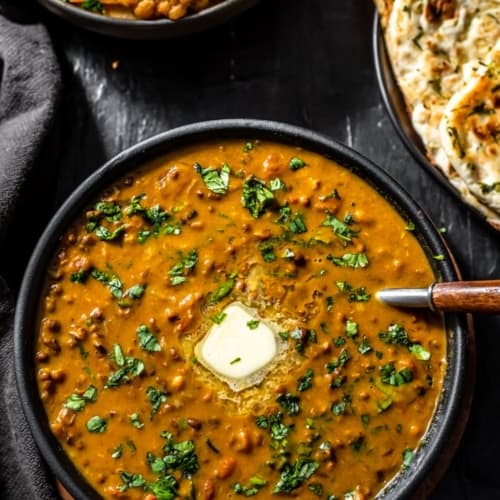
Chana masala
Chana masala, widely known as Punjabi choley, is a flavorful, high-protein dish that appeals to meat lovers and vegans and is perfect for a crowd.
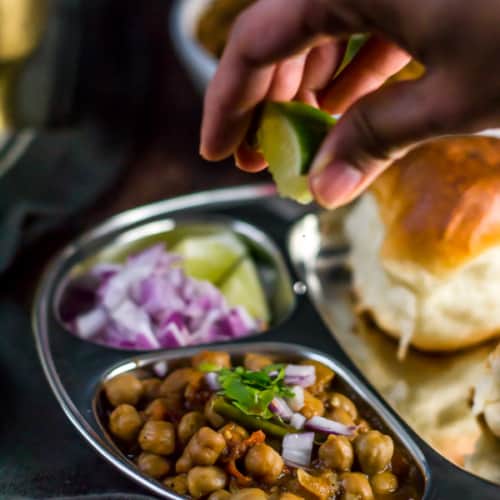
Rajma masala
Use your Instant Pot or stovetop pressure cooker to make this quick & delicious dhaba-style Punjabi rajma masala. While you can serve it with rotis, the combination of rajma and chawal (rice) is what makes this dish truly special.
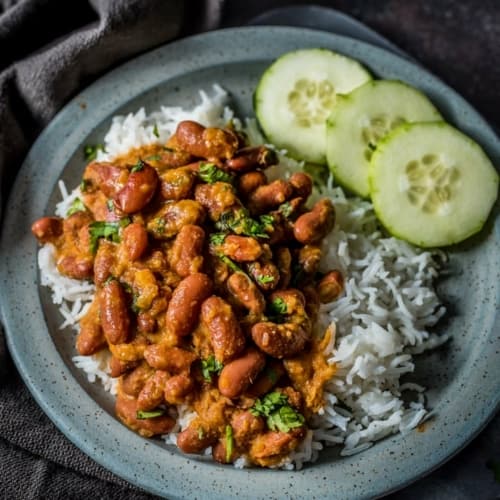
Saag/palak paneer
If you have never had palak paneer before, think of it as a mildly spicy, creamy curry made from spinach and cottage cheese and a few basic Indian spices. The silky texture makes it a popular dish to dunk your naans in.
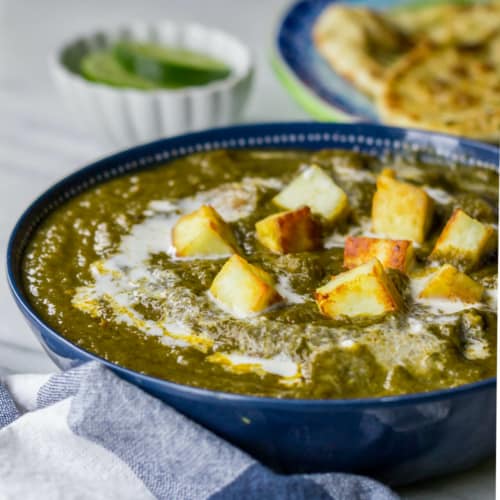
Paneer makhani
Learn how to make your favorite take-out curry – restaurant-style paneer butter masala or paneer makhani at home in less than 40 minutes!
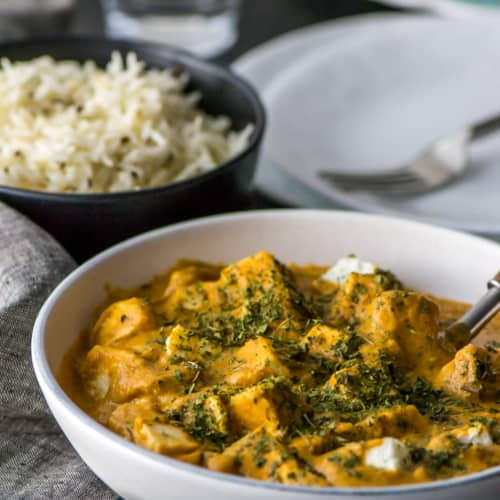
Paneer tikka masala
This restaurant-quality paneer butter masala is so easy to make that you will not consider takeout again.
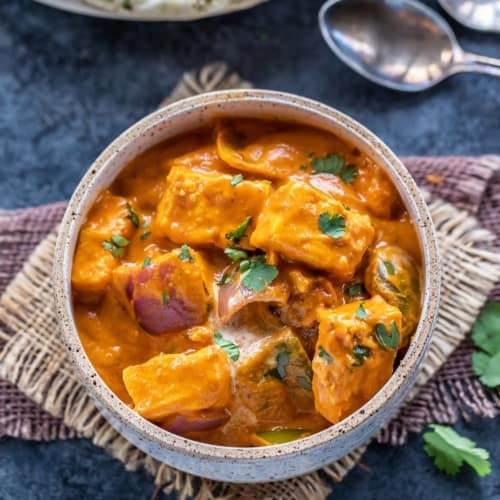
Paneer pasanda
Restaurant-style paneer pasanda is a rich, delicious, creamy curry with stuffed paneer sandwiches.
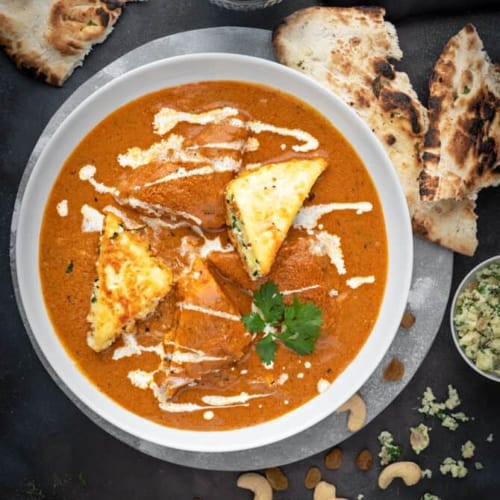
Methi malai paneer
Methi malai matar paneer is an unforgettable vegetarian dish made with fresh fenugreek leaves, green peas, and soft chunks of paneer. Learn how to make this methi malai matar meal on the stove in about 40 minutes.
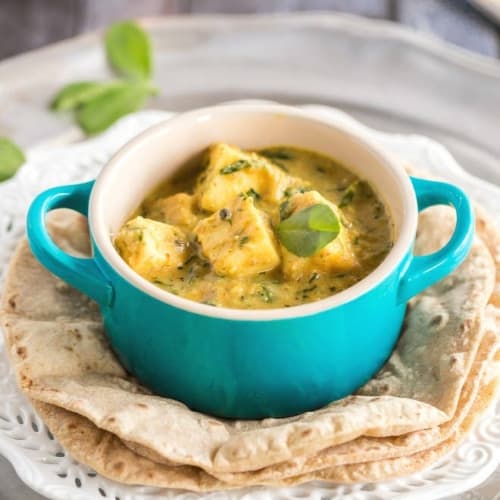
Paneer jalfrezi
This restaurant-style paneer jalfrezi is a melange of Indian cottage cheese or paneer and vegetables in a spicy onion tomato sauce.
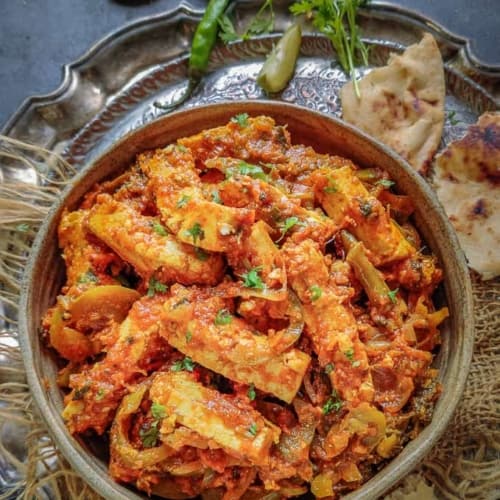
Kadhai paneer
Warm chunks of fresh paneer cook up in a spicy kadhai masala mixed with onions and peppers for this filling and flavorful dinner recipe. This easy paneer recipe comes together in 40 minutes and is packed with spices, protein, and vegetables.
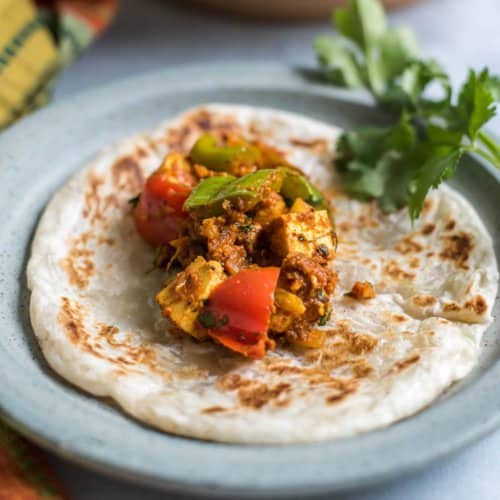
Baingan bharta
Baingan bharta is a smoky-flavored curry made by mashing fire-roasted eggplants and cooking them in a rich onion-tomato gravy. A popular North Indian dish, baingan bharta pairs well with roti or rice.
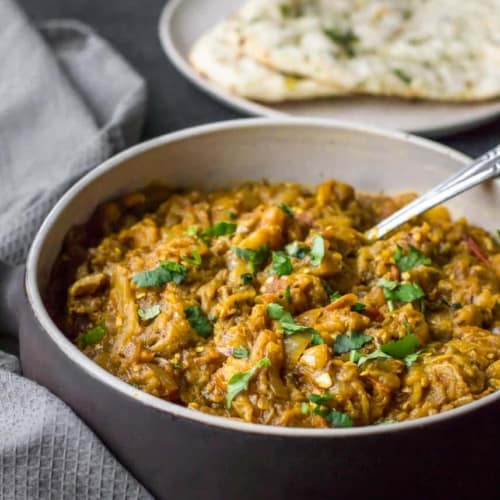
Malai kofta
Malai kofta is a delicious Indian curry made by dunking deep-fried potato and paneer balls (kofta) in a rich, velvety smooth gravy.
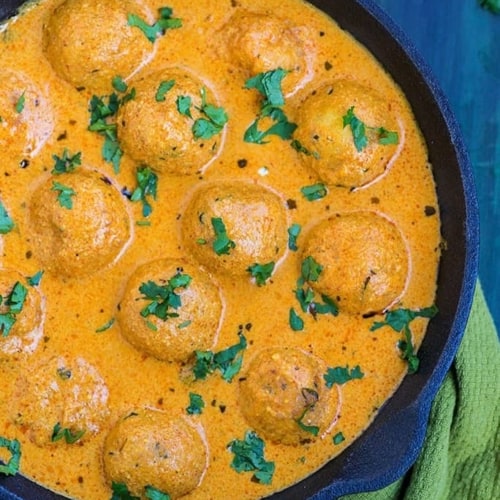
Gujarati kadhi
Kadhi or Karhi is a yogurt-based curry that is popular in the northern and western parts of India. To make this dish, thick yogurt is traditionally mixed with besan (chickpea flour) and watered down to the desired consistency. It is then cooked until the raw taste of the besan disappears. A tempering of mustard, cumin, and curry leaves is added to finish the dish.
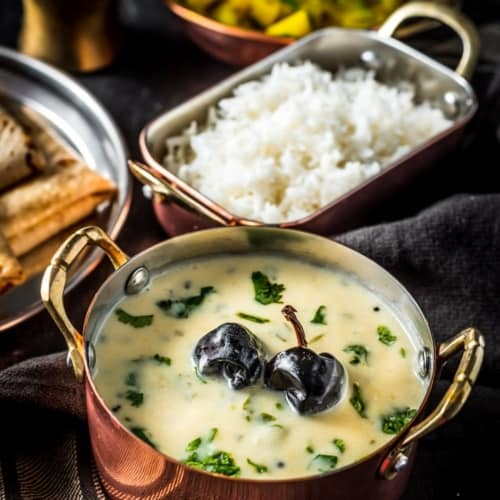
Mirchi ka salan
Mirchi ka salan (biryani salan) is a Hyderabadi-style nutty and spicy curry made using large green chilies. Serve it with biryani or any Indian bread (vegan, gluten-free).
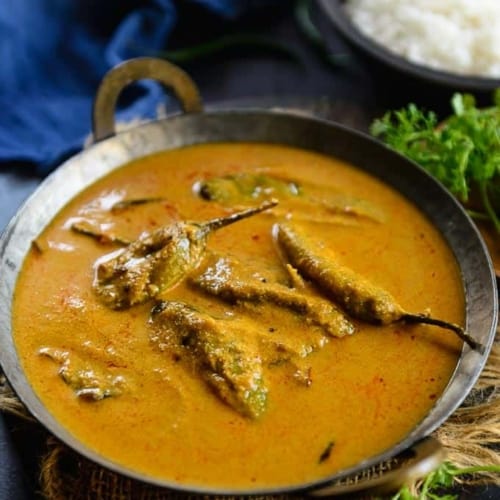
Dum aloo
Dum aloo is traditionally made by deep-frying whole potatoes and then slow-cooking them in an onion-tomato-based gravy. It is a popular north Indian dish and is commonly found in most Indian restaurants. This recipe calls for shallow frying potatoes and is a healthier take on the classic dum aloo recipe.
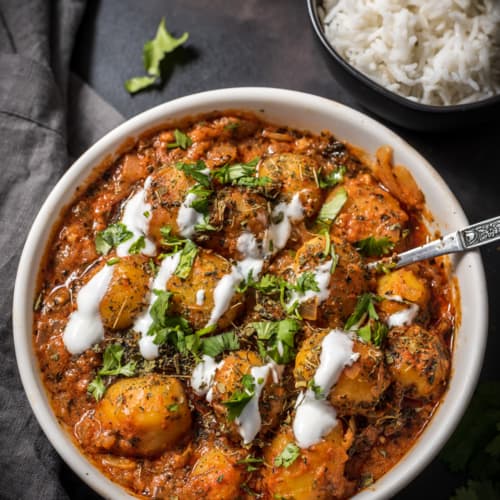
Vegetable korma
Indian veg Korma is a comforting dish with tender mixed vegetables in a creamy, rich, flavorful yogurt sauce. It’s a classic mild curry recipe that’s surprisingly easy to prepare in an Instant Pot or on the stovetop!
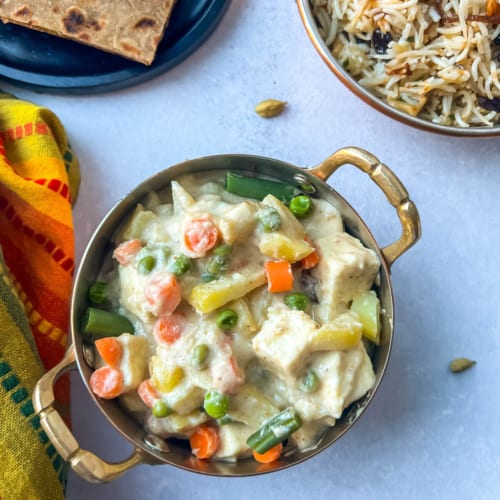
Indian chicken and lamb curries
Chicken tikka masala
Grilled chicken pieces (tikkas) which are crisp on the outside and succulent on the side, are added to a creamy onion-tomato-based gravy to make this finger-licking Indian chicken dish.
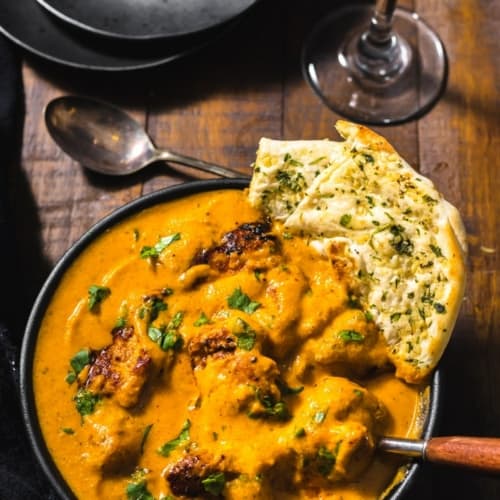
Chicken makhani (murg makhani)
Butter chicken or chicken makhani is one of the most popular North Indian dishes in which boneless chicken thighs are cooked in a buttery onion-tomato sauce with a medley of spices. Try this delicious Indian chicken curry with naan bread or steamed rice.
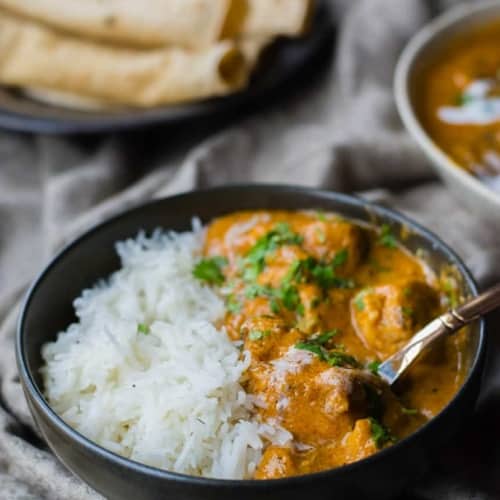
Chicken curry (murgh curry)
There are so many things you can do with chicken, but lately, we’ve been loving this spicy and aromatic North Indian-style chicken curry. This simple and easy Indian curry chicken recipe is one more reason you’ll love cooking in your Instant Pot.
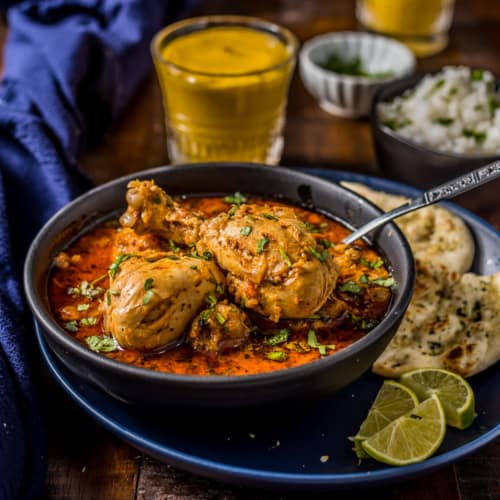
Chicken karahi or kadhai
Chicken karahi is a popular North Indian and Pakistani curry; you can find it on most restaurant menus. The roadside dhabas often have this spicy, homestyle curry on the menu, which is often enjoyed with hot naan or roti right from the tandoor.
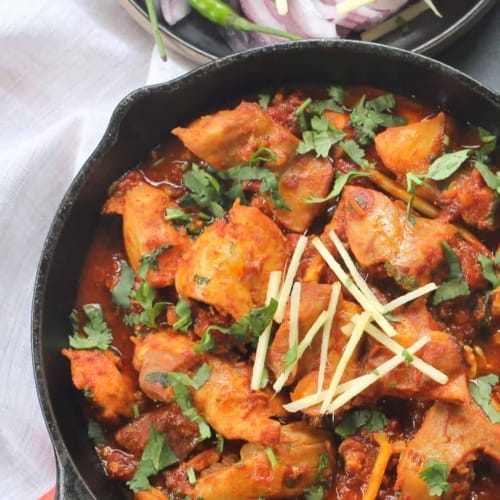
Chettinad chicken curry
This dish stands out because of its rich, spicy, and aromatic flavor. It is always cooked with a special blend of freshly roasted and ground spice mix or masala. The fresh masala infuses the dish with all its flavors and gives the Chettinad chicken its gorgeous aroma and signature spicy taste.
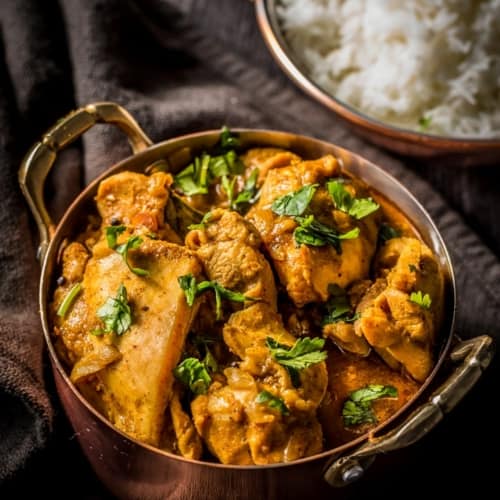
Chicken dhansak
Dhansak is a popular Parsi dish prepared with lentils (mostly red or yellow), vegetables, and spices. The non-vegetarian version typically uses goat meat, but it has been substituted with chicken in the recipe below.
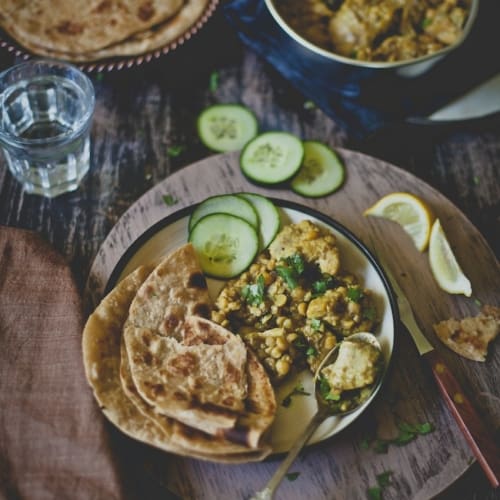
Chicken kheema
Popular street food in India, kheema or keema, is a robust, peppery curry dish made with minced chicken or lamb cooked with onion, tomatoes, ginger, garlic, and earthy spices! Serve it with lightly toasted, buttery ladi pav (dinner rolls) for a blissful meal!
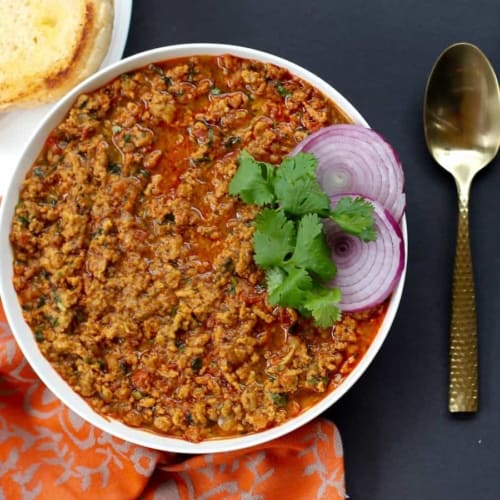
Chicken saag
Saag Chicken is a popular takeout dish at any Indian restaurant and is extremely easy to make at home. Check out this quick and easy 30-minute one-pot recipe.
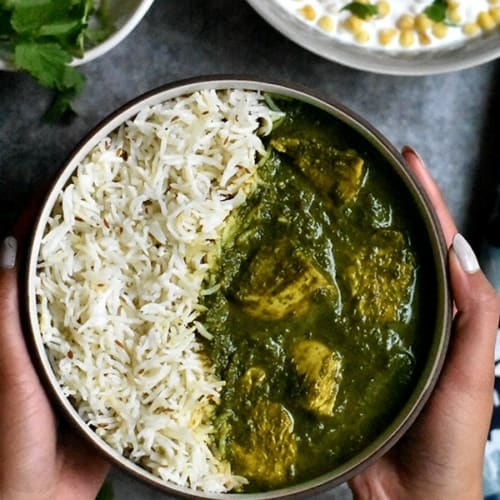
Mangalorean chicken curry (kori gassi)
Mangalorean chicken curry or Kori Gassi is a chicken curry like no other. This fiery red chicken curry combines the mild sweetness of full-fat coconut milk with a medley of whole spices to create a complexly flavored curry that is a treat to your senses.
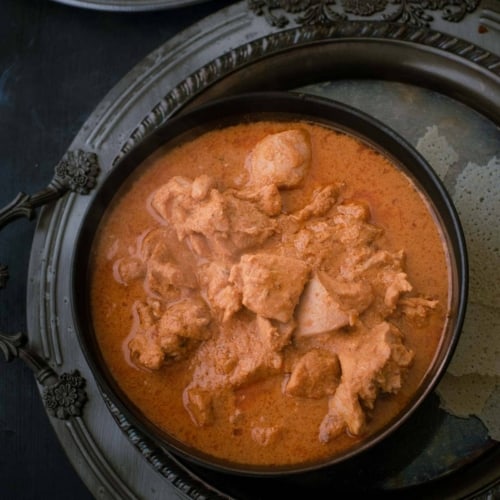
Chicken vindaloo
Learn how to make this tangy finger-licking chicken vindaloo curry in an Instant Pot or Stovetop. It is gluten and dairy-free and absolutely delicious! Serve it with warm pav (dinner rolls) for an authentic experience.
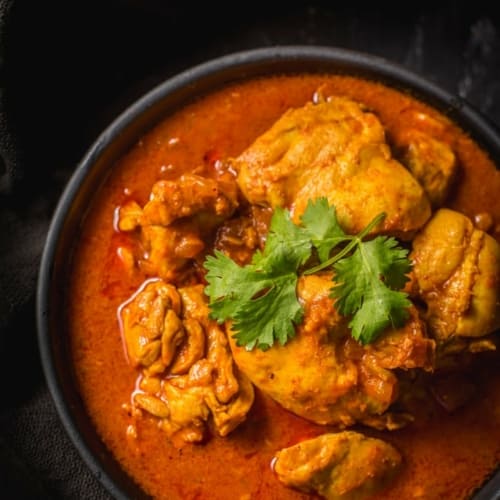
Bhuna gosht
Bhuna Gosht is goat or lamb meat slow-cooked with spices by simmering it for an hour. It is then roasted or fried on high heat till it reaches deep red thick luscious gravy. Meat is cooked in its own juices and blends beautifully with the spices, giving out an elegant, aromatic dish.
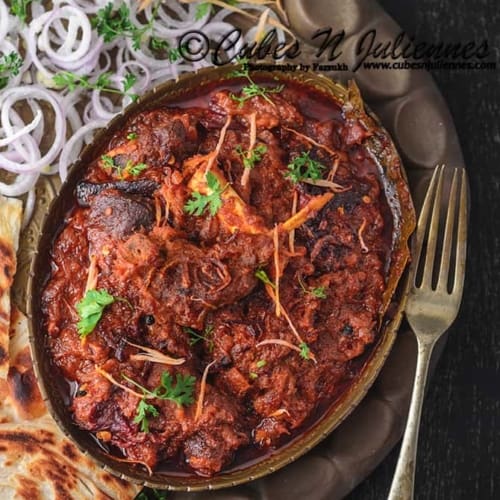
Dal gosht
Curries that contain goat meat (also called lamb or mutton in India) are named gosht. These curries can be made in any number of ways and sometimes combined with lentils, as in the daal gosht recipe below.
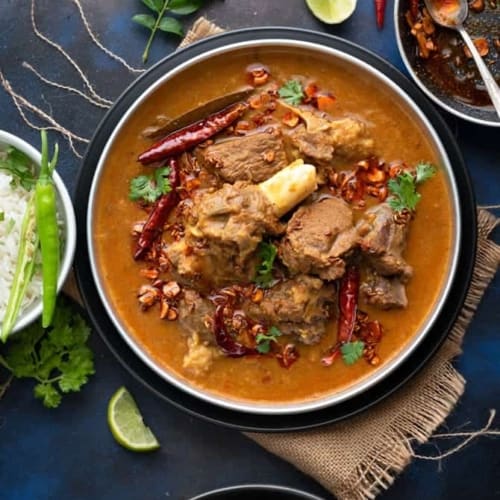
Indian seafood curries
Goan fish curry
Goa (a state on the west coast of India) is famous for its beaches and good food, especially fish curries. These tangy curries use local ingredients like kokum and, sometimes, even vinegar, resulting from Portuguese influence in the area. To top it up, they almost always have coconut added to them, like in this fish curry recipe below.
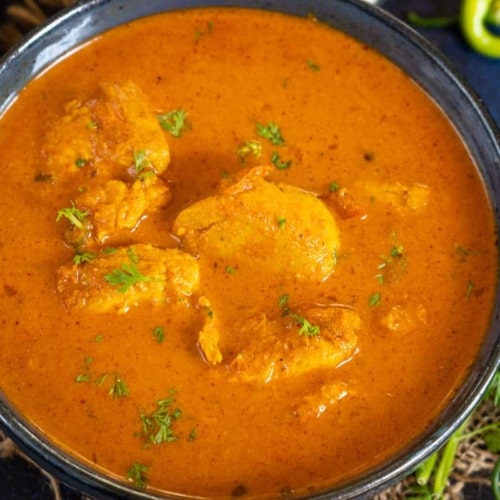
Fish moilee
Fish Molee (Fish Molly or Meen Moilee) is a Kerala-style fish curry where fish is cooked in a coconut milk-based gravy. Enjoy this curry with a bowl of steamed rice or appam.
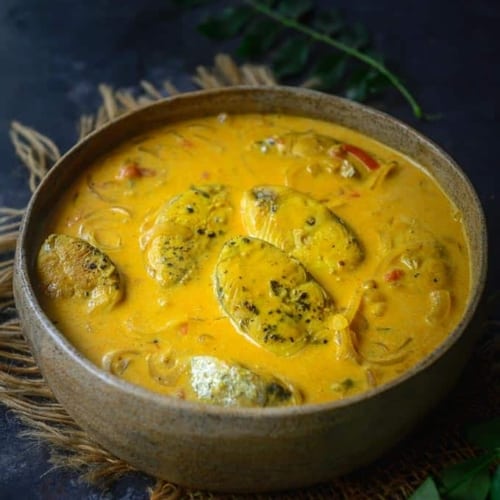
Prawn balchao
This seafood curry from Goa is a must-try in my book. It is spicy and tangy and goes really well with steamed Basmati rice.
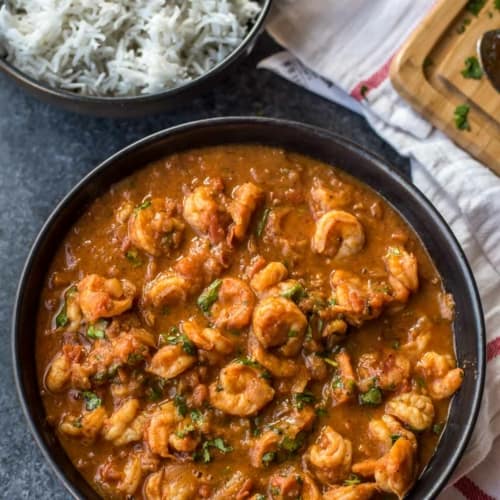
Mangalorean fish curry (meen gassi)
Meen Gassi (Mangalorean fish curry) is a popular dish served with rice in the coastal area of Mangalore, located in the southern state of Karnataka, India.
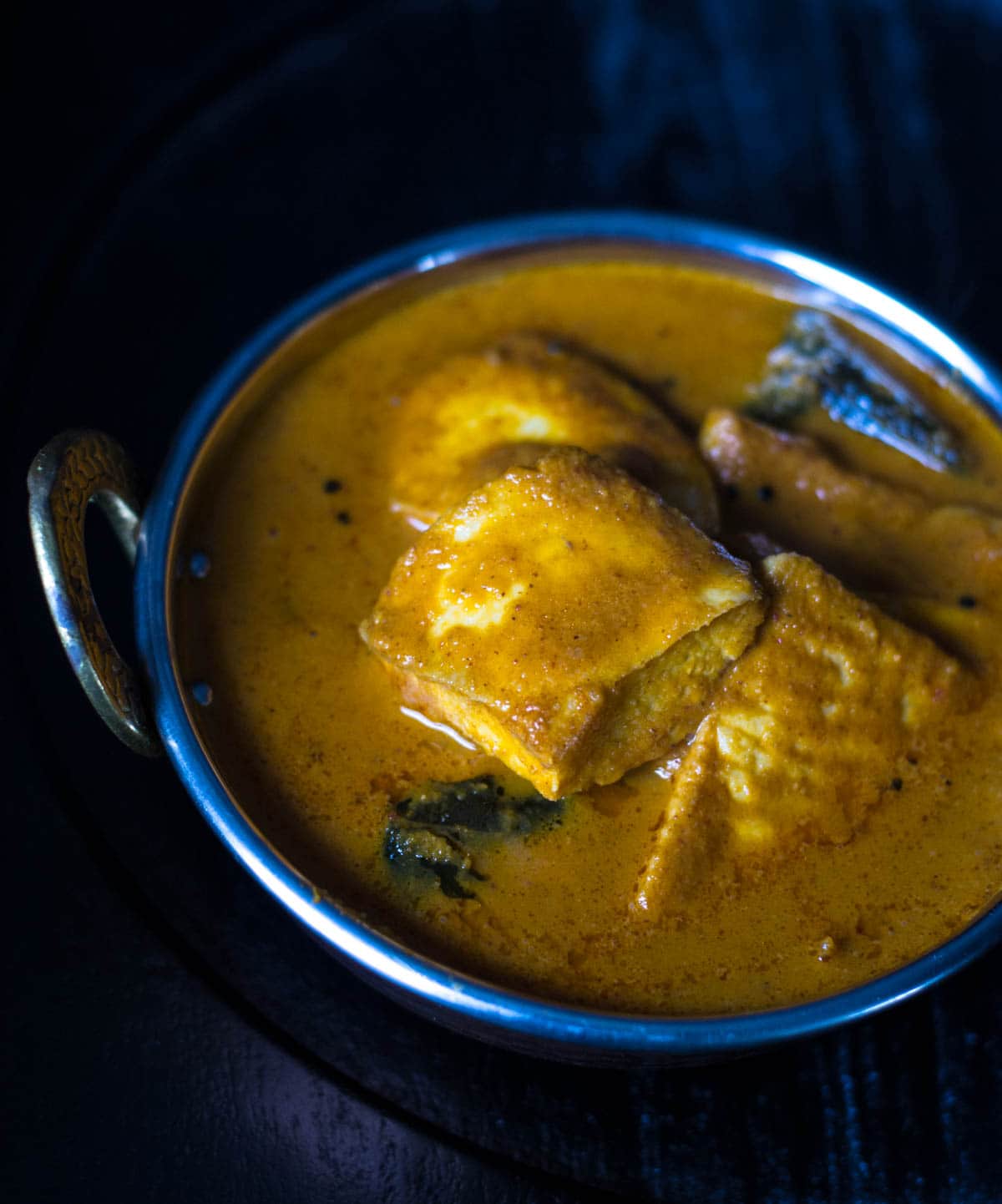
Salmon tikka masala
This delicious fish curry combines marinated bite-sized pieces of salmon in a creamy, spiced tikka masala sauce. Serve it with naan or Basmati rice and some onion raita to make it an extra-special weeknight dinner.
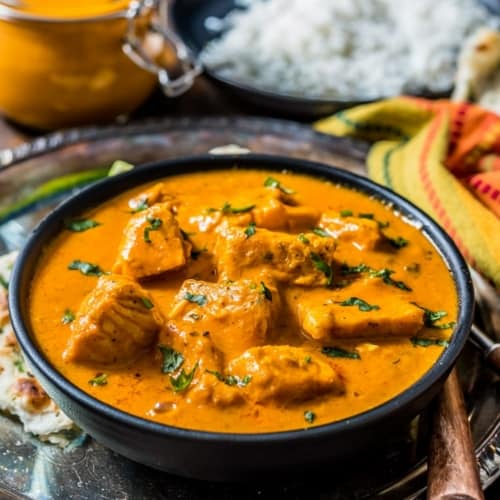
This is in no way an exhaustive list of Indian curries – there are probably quite a few regional ones that I may have missed. If you know of one that should be part of the list, please leave me a comment, and I’ll add them in.
What to serve with curries?
Soft and fluffy rotis, pooris, plain or jeera rice, naan, tandoori roti, etc. – all pair really well with curries. Typically, curries with a lot of sauce are consumed with rice; for rotis, most people prefer dry curries. There is no hard and fast rule – you be you! Enjoy your curries with any bread or rice dish you like 🙂
Here’s a collection of both rice side dishes and Indian flatbreads for you to accompany your delicious curries.
Hope you enjoyed this list of authentic and easy Indian curries. Please feel free to share it with your friends who share our love for Indian food.
Other recipe collections to check out
- 10+ Indian chutney recipes – These authentic and tantalizing Indian chutney recipes are just what you need to elevate your meals. Check out this collection of 10+ popular chutney recipes that are perfect with Indian breakfast, snacks, and main courses too.
- 35+ Best Indian breakfast recipes – Running out of ideas on what to make for breakfast? Here’s a list of easy Indian breakfast recipes for your inspiration so that you are never bored eating the same things over and over.
- 35+ Popular Indian side dish recipes – If you love Indian cuisine, here are a few easy-to-make, popular Indian side dish recipes to get you started. Stop doing takeouts and make your favorite restaurant-style side dish at home.
- 45+ Easy Indian Sweets and Desserts that are a must-try – Check out this extensive list of 45+ easy dessert recipes from all over India. They are perfect for dinner parties, festivals, or days when you crave something sweet.
This post was published on August 27, 2019, and has been completely updated with new information on April 26, 2023.

